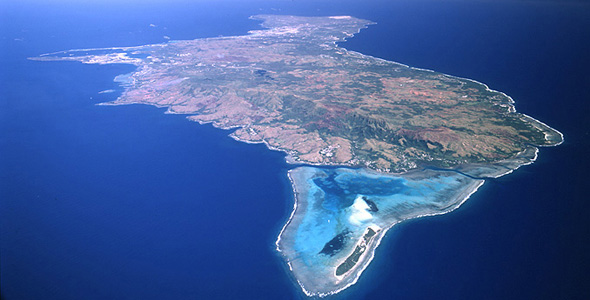More and more Chinese tourists prefer trips to exotic destinations of the Pacific Islands, such as Saipan and Guam.
 Saipan
Saipan
Safety concerns, better travel options help lesser-known destinations gain an edge over once-popular locales.
Political uncertainties in some Southeast Asian nations are propelling Chinese tourists to such exotic destinations as Hawaii, Saipan and
Guam in the Pacific and also helping boost local tourism industries in these regions, tourism sources said.
Jiang Yiyi, director of the China Tourism Academy's international tourism development division, said that the number of outbound tourists from China will cross 100million this year.
"It is obvious that newer destinations will benefit from the increased outflows," he said.
According to Jiang, nearly one-third of the Chinese tourists are self-guided travelers who prefer trips to exotic destinations like the Pacific Islands. Other destinations like Japan and South Korea also are gaining in popularity with Chinese tourists because of the continued political problems in some Southeast Asian nations.
"The Pacific Islands will be the main beneficiary of the increased tourist flows as many of the islands are new and unexplored destinations," she said.
 Guam
Guam
Hawaii, which comprises several different islands, has already become popular with Chinese travelers. According to Hawaii's tourism bureau, more than 110,000 Chinese tourists visited the islands in 2012 and the number should reach 144,000 this year.
Some carriers have already started to operate direct flights between Beijing and Honolulu.
Air China Co Ltd launched direct flights on the route in January and three-months later, Hawaiian Airlines Inc also commenced triweekly flights.
Hawaiian Airlines, which has a well-woven network in Hawaii, is planning to add more flights on the route and connect to more destinations in China, if the demand grows, said Mark Dunkerly, president and CEO of Hawaiian Airlines.
Saipan is another Pacific island that belongs to
the United States that is fast becoming popular with Chinese travelers, especially as it
has a visa-on-arrival policy for Chinese tourists.
"The visa policy of Saipan is even more convenient than some Southeast Asian countries," said Xie Ting, a 27-year-old office worker from Xi'an, Shaanxi province.
Xie spent her holiday in Saipanin May, though her original plan was to go to Phuket Island in
Thailand. "I changed my plans, as I was worried that the local political events would affect my holiday," she said.
Charter flights operated by some carriers like China Southern Airlines Co Ltd, Sichuan Airlines Co Ltd and Asiana Airlines Inc provided multiple choices for Xie to arrive in Saipan, although there are no regular direct flights between China and the island.
Though there is considerable interest among Chinese tourists for trips to Pacific islands, many of these destinations still need to spruce up facilities.
There are 29 hotels with 8,451 rooms in Guam, an over-seas territory of the US, that is slowly becoming popular with Chinese tourists. High-end hotels account for 31.3 percent of the total, and there are no super-luxury hotels, according to the Guam Visitor Bureau.
The bureau plans to increase the number of hotels to 35 and have 10,091 rooms by 2020. Super-luxury hotels will account for 10 percent of the total by then, said the bureau. Fong S.Wu, a second-generation Chinese in Guam and CEO of Pago Bay Resort, who is building a luxury hotel on the island, said his hotel will have some features especially for Chinese travelers, including food, music and Mandarin services.
The hotel, which will be managed by an international luxury brand, such as Marriott International Inc, Star wood Hotels & Resorts Worldwide Inc or Banyan Tree Holdings Ltd, will have 600 rooms, and 50 percent of them will be sold to Chinese residents.
"We want Chinese residents to be involved in investment here, and not just as tourists," Wu said. By the end of September, the number of Chinese travelers to Guam is expected to be around 20,000, which is double that of last year, officials from the Guam Visitor Bureau said.
"Thanks to the charter flights, we will see huge growth in Chinese visitors," said Pilar Laguana, marketing manager of Guam Visitor Bureau, the most important government department on the island, as tourism is a pillar industry.
Dynamic Airways LLC, a US-based carrier, has launched direct scheduled charter flights between Beijing and Guam from June 21 and the carrier flies every five days with a capacity for 235 passengers. The direct flights from Beijing to Guam take only five hours and is even shorter than trips to some islands in Southeast Asia.
"As Chinese tourists are very keen on visiting the US, we believe Guam will become one of the favorable short-haul holiday destinations," said Paul Kraus, managing partner of Dynamic Airways.
The carrier with five Boeing 767 aircraft, is also working on charter flights from smaller Chinese cities to Guam, and a route from Chengdu was launched on July 19.
"China is the No 1 visitor source market in the world, and it continues to grow rapidly," said Karl Pangelinan, general manager of Guam Visitors Bureau, "It's absolutely essential for Guam to get its foot in the door with this expanding market."
According to the Tourism 2020 plan, Chinese travelers will account for 5.7 percent of the entire tourism market on the island by 2020, which was only 0.7 percent in 2012, and if Guam can provide a visa-free policy to Chinese travelers, the number should rise to 17.5 percent with 350,000 visitors then.

